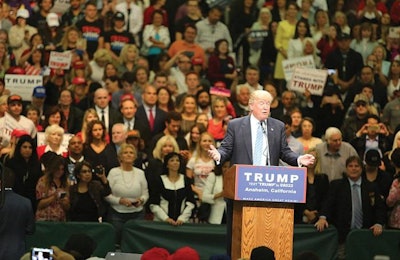
A key factor in the business outlook for the U.S. poultry industry changed with the election of Donald Trump as the 45th president of the United States.
Speaking at the National Chicken Council Annual Conference just days before the 2016 election, political analyst Charlie Cook said Donald Trump had no chance of being elected president of the United States and Hillary Clinton was the presumptive president elect. The political, regulatory and economic calculus is now radically different.
From the same podium, Ambassador William J. Burns, former deputy secretary of state in the Obama administration, expounded on America’s enshrined doctrines of multilateral global diplomacy and trade. If Trump has his way, it would shatter much of the globalist dogma ushered in by the Reagan administration and continued in succeeding ones.
On the economy, the dean and professor of International Business at the Tuck School at Dartmouth College and former member of the Council of Economic Advisers in the Executive Office of the president surveyed projections for slow growth in 2017 for the U.S. (2.2 percent) and the world’s advanced economies (1.8 percent). Trump confidently says 4 percent U.S. economic growth can be achieved.

Growth in economic output is slow because productivity growth is slowing.
Trump’s vision complicated for poultry
The question is: Just how have the political, regulatory and economic outlooks changed for the U.S. poultry industry? It remains to be seen how Trump’s pro-business policies would impact the U.S. poultry industry.
While a lightening of the regulatory burden would be favorable for all businesses, Trump’s campaign pledges, if implemented in policy, could impact the poultry industry in unpredicatble ways on trade, the availability of labor, government regulations and the economic growth that spurs consumer spending on food. For one thing, U.S. poultry and red meats have historically been the sacrificial lamb when trade upsets occur.
In early December 2016, as Trump conducted his "Thank You" tour of the electoral swing states that gave him the presidency – promising to fulfill promises to rectify unfair trade practices, secure borders, strike down arbitrary regulations, foster job creation and economic growth – sitting President Obama lectured the American people that Trump would not be able to make good on those promises.
Trump, however, told a crowd in Fayetteville, North Carolina: “I’m asking you to dream big again as Americans. I’m asking you to believe in yourself. I’m asking you to believe in your country and to believe in your future.”
Too little confidence in America
Citing global attitude surveys, Tuck business school professor Matthew Slaughter told NCC members that in advanced economies there is little optimism for the next generation. Sixty-five percent say their children will be worse off financially than the present generation, while only 28 percent say their children will be better off. The numbers are even worse in the U.S., where only 21 percent believe the next generation of children will be better off.

“I, for one, am hopeful [about the economic outlook]. It beats the alternative, and it often is surprisingly correct,” said Matthew Slaughter, Dean of the Tuck School of business.
A survey in September 2016 indicated that 69 percent of people in the U.S. believed the country was on the wrong track, while only 27 percent thought the country was on the right track.
“What both Bernie Sanders and Donald Trump tapped into in their presidential campaigns is that the slowly rising economic tide has been lifting very few boats,” Slaughter said.
“U.S. real median household income in 2015 was $56,516. This was barely above the level first reached in 1989, and it was 2.4 percent below the level reached in 1999,” he said.
In fact, only the highest educational groups (PhD, MD, JD, MBA) representing 4 percent of the U.S. population experienced rises in real total earnings from 2000 to 2014.
Growth is slow in advanced economies
Slaughter presented world economic outlook projections for slow growth in output in the advanced economies. In the U.S., it dropped from 2.6 percent in 2015 to a projected 1.6 percent in 2016. The projection for the U.S. in 2017 is a tepid 2.2 percent.
Why is growth so slow? “Mainly because productivity growth is slowing,” he said. “U.S. average annual labor productivity growth for 2011-2015 averaged just 0.6 percent. At this rate, average standard of living takes 116 years to double.”
Will Trump’s policies drive economic growth?
How do countries grow their economies and raise earnings? “Mainly through productivity growth,” Slaughter said. “Productivity booms – the kind that create entire industries, unleash productivity, slash costs, create jobs, boost incomes and generate billions in profits – tend to be driven by companies that are some combination of young, nimble and global.
“Governments can boost probability of private-sector productivity growth through wise policies on tax, trade, immigration, research and infrastructure. The fundamental question is will governments have the courage and will to pursue these policies?”
He pointed to immigration policy – a policy area in which many U.S. poultry industry leaders have advocated reform – as a potential booster for economic growth. “Will government leaders bring on [positive conditions for growth] via high-skilled immigration liberalization?” he asked.
Again, the policy outlook for poultry is complicated. While poultry producers would benefit from immigration reforms that bring skilled people into the workforce, their biggest need is for lower-skilled workers.
Questions about trade, immigration policy
It remains to be seen how the policies of the Trump administration will impact the U.S. poultry industry. While a lessening of the regulatory burden on U.S. business would benefit poultry producers, the impact of Trump’s policies – especially on trade and immigration – are impossible to predict. The U.S. poultry industry faces new and unpredictable challenges and opportunities in 2017 with Donald Trump in the White House.

NCC Chairman Mike Popowycz is hopeful that meaningful immigration reform will occur in 2017.


















